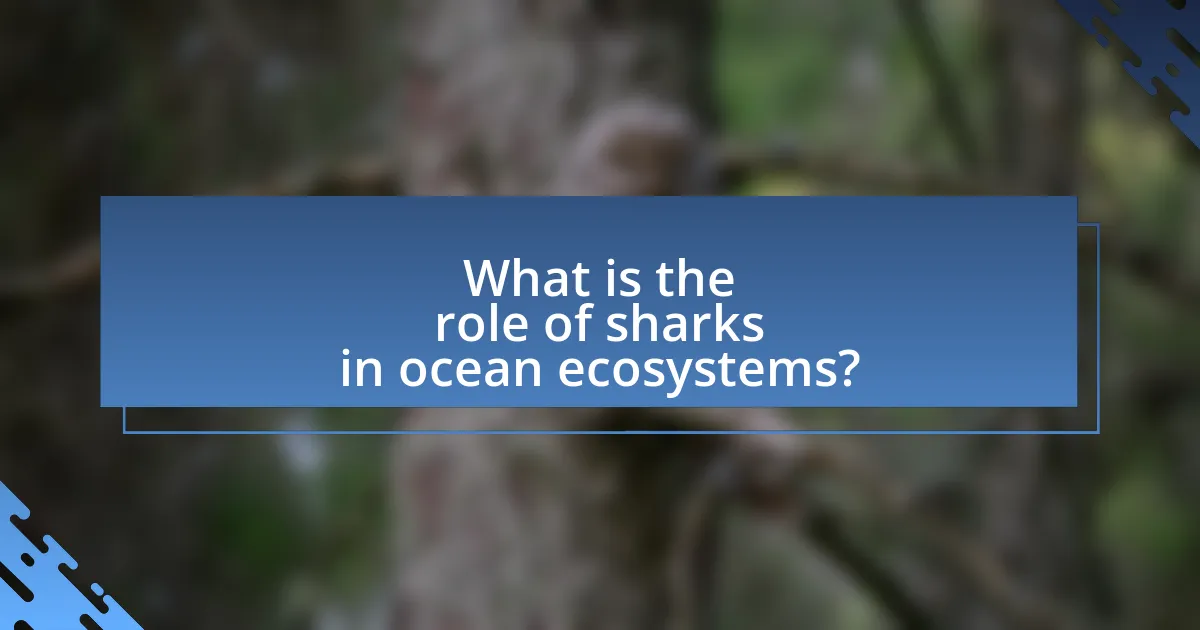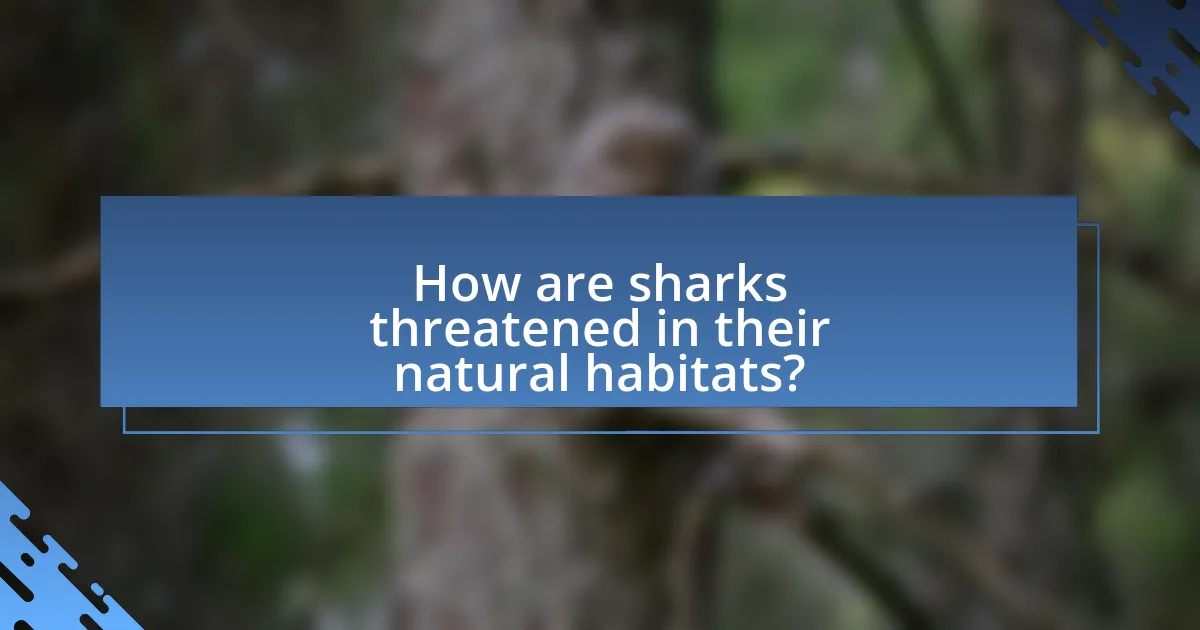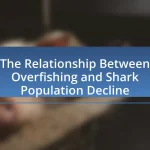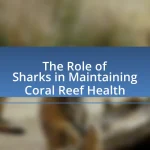Sharks are apex predators that play a vital role in maintaining the balance of ocean ecosystems. They regulate fish populations, which supports the health of coral reefs and seagrass beds, and their decline can lead to significant ecological imbalances. The article explores the importance of sharks in marine biodiversity, their specific roles in food webs, and the consequences of declining populations due to threats such as overfishing, habitat destruction, and climate change. It also discusses conservation efforts, including marine protected areas and international agreements, aimed at preserving shark species and their habitats.

What is the role of sharks in ocean ecosystems?
Sharks play a crucial role in ocean ecosystems as apex predators, helping to maintain the balance of marine life. By preying on various species, sharks regulate fish populations, which in turn supports the health of coral reefs and seagrass beds. Research indicates that the removal of sharks can lead to overpopulation of certain fish species, resulting in the decline of biodiversity and the degradation of habitats. For example, a study published in the journal “Ecology Letters” found that areas with healthy shark populations had more diverse and stable marine ecosystems. This highlights the importance of sharks in preserving ecological balance and promoting overall ocean health.
How do sharks contribute to marine biodiversity?
Sharks contribute to marine biodiversity by serving as apex predators that help maintain the balance of marine ecosystems. Their predation regulates the populations of various species, preventing any single group from dominating the ecosystem. For instance, studies have shown that the removal of sharks can lead to an increase in the population of smaller fish and invertebrates, which can disrupt the entire food web. This balance is crucial for the health of coral reefs and other marine habitats, as it promotes species diversity and resilience. Additionally, sharks help to control the health of prey populations, ensuring that weaker individuals are removed, which supports the overall health of marine species.
What specific roles do sharks play in food webs?
Sharks serve as apex predators in marine food webs, regulating the populations of prey species and maintaining the balance of the ecosystem. By preying on weaker or sick individuals, sharks help ensure the health of fish populations, which in turn supports the overall biodiversity of the ocean. Research indicates that the removal of sharks can lead to an overabundance of smaller fish species, resulting in the depletion of seagrass and coral reef habitats due to overgrazing. This dynamic illustrates the critical role sharks play in maintaining ecological stability and promoting healthy marine environments.
How do sharks influence the population dynamics of other marine species?
Sharks influence the population dynamics of other marine species primarily through their role as apex predators, which helps maintain the balance of marine ecosystems. By preying on various species, sharks regulate the populations of those species, preventing overpopulation and promoting biodiversity. For instance, studies have shown that the removal of sharks from an ecosystem can lead to an increase in the population of smaller predatory fish, which in turn can deplete herbivore populations, resulting in overgrazing of seagrass and coral reefs. This cascading effect underscores the importance of sharks in maintaining the health and stability of marine environments.
Why are sharks considered apex predators?
Sharks are considered apex predators because they occupy the top of the marine food chain, exerting significant control over the populations of other species. Their role as apex predators helps maintain the balance of marine ecosystems by regulating prey populations, which in turn supports biodiversity. Research indicates that the removal of sharks can lead to overpopulation of certain species, such as herbivorous fish, which can devastate coral reefs and disrupt the entire ecosystem. For example, studies have shown that in areas where shark populations have declined, there is a corresponding increase in the numbers of smaller fish that graze on seagrass and coral, leading to habitat degradation. This evidence underscores the critical role sharks play in sustaining healthy ocean environments.
What characteristics define apex predators in marine environments?
Apex predators in marine environments are characterized by their position at the top of the food chain, which allows them to regulate the populations of other species. These predators, such as sharks, possess traits including large size, powerful predatory skills, and specialized adaptations for hunting, such as keen senses and speed. For instance, great white sharks can detect a drop of blood in the ocean from miles away, showcasing their acute sense of smell. Additionally, apex predators often have few natural enemies, which enables them to maintain their dominance in the ecosystem. Their role is crucial for maintaining the balance of marine ecosystems, as they help control the populations of prey species, preventing overgrazing of vegetation and promoting biodiversity.
How do apex predators like sharks maintain ecosystem balance?
Apex predators like sharks maintain ecosystem balance by regulating the populations of prey species, which helps to prevent overgrazing and promotes biodiversity. Sharks primarily target weak or sick individuals, ensuring that the healthiest members of prey populations survive and reproduce. This selective predation fosters a balanced food web, as evidenced by studies showing that the removal of sharks can lead to an increase in herbivorous fish, which in turn can decimate seagrass beds and coral reefs. For instance, research published in the journal “Ecology Letters” highlights that in areas where shark populations have declined, there has been a significant rise in the numbers of smaller fish, leading to detrimental effects on marine habitats.
What are the ecological impacts of declining shark populations?
Declining shark populations lead to significant ecological imbalances in marine ecosystems. Sharks are apex predators, and their reduction disrupts the food chain, resulting in overpopulation of prey species such as smaller fish and invertebrates. This overpopulation can lead to the depletion of seagrass and coral reef habitats, as these species overgraze on essential vegetation. For instance, studies have shown that in areas where shark populations have decreased, there is a notable increase in the numbers of herbivorous fish, which can devastate coral reefs by overgrazing. Furthermore, the loss of sharks can alter the behavior of other marine species, leading to changes in community structure and biodiversity. Research published in the journal “Nature” highlights that the decline of large predatory fish, including sharks, can result in cascading effects throughout the ecosystem, ultimately affecting the health of ocean environments.
How does the loss of sharks affect prey species?
The loss of sharks significantly increases the population of prey species, leading to ecological imbalances. Sharks are apex predators that regulate the populations of species below them in the food chain, such as smaller fish and invertebrates. When shark populations decline, these prey species often experience unchecked growth, which can result in overgrazing of vital habitats like coral reefs and seagrass beds. For instance, studies have shown that in areas where sharks have been overfished, the populations of herbivorous fish can explode, leading to the depletion of algae that are crucial for coral health. This disruption can ultimately harm the entire marine ecosystem, demonstrating the critical role sharks play in maintaining balance within oceanic environments.
What are the broader implications for ocean health?
The broader implications for ocean health include the maintenance of biodiversity, the regulation of marine ecosystems, and the overall resilience of oceanic environments. Sharks play a crucial role as apex predators, helping to control the populations of other marine species, which in turn supports the balance of the ecosystem. For instance, studies have shown that the decline of shark populations can lead to an increase in smaller fish species, which can overgraze on vital habitats like seagrass and coral reefs, ultimately degrading these ecosystems. This degradation can result in diminished fish stocks, reduced carbon sequestration, and increased vulnerability to climate change impacts, highlighting the interconnectedness of species and the health of ocean environments.

How are sharks threatened in their natural habitats?
Sharks are threatened in their natural habitats primarily due to overfishing, habitat loss, and pollution. Overfishing occurs as sharks are targeted for their fins, meat, and other body parts, leading to significant population declines; for instance, it is estimated that up to 100 million sharks are killed annually, severely impacting their populations. Habitat loss results from coastal development and destructive fishing practices, which degrade essential environments like coral reefs and mangroves that are crucial for shark breeding and feeding. Additionally, pollution, including plastic waste and chemical runoff, contaminates marine ecosystems, affecting shark health and their prey availability. These factors collectively jeopardize the survival of shark species and disrupt the balance of ocean ecosystems.
What are the primary threats to shark populations?
The primary threats to shark populations include overfishing, habitat loss, and climate change. Overfishing occurs due to high demand for shark fins and meat, leading to significant declines in shark numbers; for instance, it is estimated that up to 100 million sharks are killed annually. Habitat loss results from coastal development and pollution, which degrade essential breeding and nursery areas for sharks. Climate change affects ocean temperatures and acidification, disrupting shark migration patterns and prey availability. These factors collectively threaten the survival of various shark species, highlighting the urgent need for conservation efforts.
How does overfishing impact shark species?
Overfishing significantly reduces shark populations, leading to ecological imbalances in marine ecosystems. Sharks are apex predators, and their decline disrupts the food chain, resulting in overpopulation of prey species and subsequent degradation of coral reefs and seagrass beds. For instance, studies have shown that the removal of large shark species can lead to a 50% increase in the population of smaller predatory fish, which in turn affects the abundance of herbivorous fish that help maintain healthy coral reefs. This cascading effect illustrates the critical role sharks play in maintaining the health of ocean ecosystems.
What role does habitat destruction play in shark decline?
Habitat destruction significantly contributes to shark decline by reducing the availability of essential breeding and feeding grounds. Coastal development, pollution, and climate change lead to the degradation of critical habitats such as mangroves, seagrasses, and coral reefs, which are vital for the survival of many shark species. For instance, studies indicate that over 50% of mangrove forests have been lost globally, directly impacting species like the juvenile blacktip reef shark that rely on these areas for nursery habitats. This loss of habitat not only decreases shark populations but also disrupts the overall marine ecosystem, as sharks play a crucial role in maintaining the balance of oceanic food webs.
Why is shark finning a significant concern?
Shark finning is a significant concern because it leads to the drastic decline of shark populations, which disrupts marine ecosystems. Sharks play a crucial role as apex predators, maintaining the balance of marine life by controlling the populations of other species. According to the International Union for Conservation of Nature (IUCN), over 30% of shark species are threatened with extinction due to overfishing and finning practices. This decline not only threatens the sharks themselves but also the health of ocean ecosystems, as their absence can lead to overpopulation of prey species and subsequent ecological imbalance.
What are the ethical implications of shark finning practices?
Shark finning practices raise significant ethical concerns primarily due to the inhumane treatment of sharks and the detrimental impact on marine ecosystems. The practice involves removing fins from live sharks and discarding their bodies back into the ocean, often leading to a slow and painful death. This method disregards animal welfare and violates principles of humane treatment. Furthermore, shark finning contributes to the decline of shark populations, which are crucial for maintaining the balance of marine ecosystems. Research indicates that sharks play a vital role in regulating species populations and promoting biodiversity; their removal can lead to overpopulation of prey species and subsequent ecosystem collapse. The ethical implications thus encompass both the suffering inflicted on individual sharks and the broader ecological consequences of depleting shark populations.
How does shark finning affect shark populations and ecosystems?
Shark finning significantly reduces shark populations and disrupts marine ecosystems. The practice involves removing fins and discarding the rest of the shark, leading to a drastic decline in shark numbers; studies indicate that up to 100 million sharks are killed annually for their fins. This decline affects the balance of marine ecosystems, as sharks play a crucial role as apex predators, regulating the populations of other marine species and maintaining the health of coral reefs and ocean habitats. Research published in the journal “Marine Ecology Progress Series” highlights that the loss of sharks can lead to overpopulation of prey species, resulting in ecosystem imbalances and degradation.
What is the impact of climate change on sharks?
Climate change negatively impacts sharks by altering their habitats, affecting their prey availability, and disrupting their reproductive patterns. Rising ocean temperatures lead to shifts in shark distribution, as species migrate to cooler waters, which can result in decreased populations in traditional habitats. Additionally, ocean acidification affects the marine ecosystem, reducing the abundance of prey species that sharks rely on, such as fish and cephalopods. Research indicates that changes in water temperature can also influence shark breeding cycles, potentially leading to lower reproductive success. For instance, a study published in “Global Change Biology” highlights that increased temperatures can reduce the survival rates of shark embryos, further threatening their populations.
How does ocean warming affect shark behavior and distribution?
Ocean warming significantly alters shark behavior and distribution by shifting their preferred habitats and influencing their feeding patterns. As ocean temperatures rise, many shark species migrate towards cooler waters, often moving poleward or to deeper regions to maintain their optimal thermal conditions. For instance, studies have shown that species like the great white shark have expanded their range northward along the U.S. West Coast due to increased sea surface temperatures. Additionally, warmer waters can affect prey availability, leading sharks to adjust their hunting strategies and locations. Research published in the journal “Global Change Biology” indicates that these changes in distribution can disrupt local ecosystems and impact the balance of marine life, highlighting the critical role sharks play in ocean health.
What are the potential consequences of ocean acidification for sharks?
Ocean acidification can negatively impact sharks by affecting their sensory systems, behavior, and overall health. Research indicates that increased acidity in ocean waters can impair sharks’ ability to detect prey and avoid predators, which is crucial for their survival. A study published in the journal “Global Change Biology” found that elevated CO2 levels can disrupt the olfactory cues that sharks rely on, leading to decreased hunting efficiency and increased vulnerability to threats. Additionally, ocean acidification can affect the availability of prey species, further impacting shark populations and their role in marine ecosystems.

What conservation efforts are in place for sharks?
Conservation efforts for sharks include international agreements, marine protected areas, and sustainable fishing practices. The Convention on International Trade in Endangered Species (CITES) regulates the trade of shark species to prevent overexploitation. Additionally, many countries have established marine protected areas where shark fishing is restricted, allowing populations to recover. Sustainable fishing practices, such as catch limits and bycatch reduction techniques, are also being implemented to ensure shark populations remain stable. According to the International Union for Conservation of Nature (IUCN), approximately one-third of shark species are threatened with extinction, highlighting the urgency of these conservation measures.
How do marine protected areas benefit shark populations?
Marine protected areas (MPAs) benefit shark populations by providing safe habitats that reduce human impacts such as overfishing and habitat destruction. These designated zones allow sharks to thrive, reproduce, and grow, leading to increased population sizes. Research indicates that MPAs can lead to a 50% increase in shark abundance within just a few years of establishment, as evidenced by studies conducted in the Caribbean and Pacific regions. Additionally, MPAs help maintain the ecological balance by ensuring that sharks can fulfill their role as apex predators, which is crucial for the health of marine ecosystems.
What are the criteria for establishing effective marine protected areas?
Effective marine protected areas (MPAs) are established based on criteria that include ecological significance, representativeness, and management effectiveness. Ecological significance refers to the protection of critical habitats and biodiversity hotspots, ensuring that areas with high ecological value are prioritized. Representativeness involves including a variety of marine ecosystems to capture the full range of biodiversity, which is essential for maintaining ecosystem resilience. Management effectiveness requires that MPAs have clear objectives, adequate resources, and enforcement mechanisms to ensure compliance and achieve conservation goals. These criteria are supported by studies indicating that well-designed MPAs can enhance biodiversity and improve the health of marine ecosystems, which is crucial for species like sharks that play a vital role in ocean ecosystems.
How do these areas help in the recovery of shark species?
Protected marine areas help in the recovery of shark species by providing safe habitats free from fishing pressures and habitat degradation. These areas allow shark populations to grow and reproduce without the threat of overfishing, which has been a significant factor in their decline. For instance, studies have shown that in marine protected areas (MPAs), shark populations can increase by up to 50% within a few years, demonstrating the effectiveness of these zones in fostering recovery. Additionally, MPAs contribute to the overall health of marine ecosystems, which is crucial for the survival of sharks and their prey, thereby supporting a balanced ocean environment.
What role do international agreements play in shark conservation?
International agreements play a crucial role in shark conservation by establishing legal frameworks that regulate fishing practices and protect shark populations globally. These agreements, such as the Convention on International Trade in Endangered Species of Wild Fauna and Flora (CITES) and the Convention on Migratory Species (CMS), facilitate international cooperation to manage and conserve migratory shark species. For instance, CITES regulates trade in endangered species, including certain sharks, by requiring permits for international trade, thereby helping to prevent overexploitation. Additionally, the CMS promotes the conservation of migratory species through agreements that encourage habitat protection and sustainable fishing practices. These frameworks are essential for ensuring the long-term survival of shark species, which are vital for maintaining healthy ocean ecosystems.
How effective are treaties like CITES in protecting sharks?
Treaties like CITES are moderately effective in protecting sharks, primarily by regulating international trade of endangered species. CITES, which stands for the Convention on International Trade in Endangered Species of Wild Fauna and Flora, includes several shark species listed in its appendices, which restricts their trade and aims to prevent over-exploitation. For instance, the inclusion of species like the great white shark and hammerhead shark in CITES Appendix II helps ensure that any trade is sustainable and does not threaten their survival. However, the effectiveness of CITES is often limited by enforcement challenges, lack of compliance from member countries, and the existence of illegal trade networks. Studies indicate that while CITES has raised awareness and provided a framework for conservation, actual on-the-ground protection varies significantly by region and species, impacting overall effectiveness.
What challenges do these agreements face in enforcement?
Agreements related to shark conservation face significant challenges in enforcement due to limited resources, lack of political will, and difficulties in monitoring compliance. Limited financial and human resources hinder the ability of regulatory bodies to effectively monitor shark populations and enforce regulations. Additionally, political will varies among countries, leading to inconsistent commitment to enforcement. For instance, the Convention on International Trade in Endangered Species (CITES) has seen varying levels of compliance among member states, impacting the effectiveness of shark protection measures. Furthermore, the vastness of ocean territories complicates monitoring efforts, making it challenging to track illegal fishing activities. These factors collectively undermine the enforcement of agreements aimed at protecting sharks and their ecosystems.
What can individuals do to support shark conservation?
Individuals can support shark conservation by advocating for sustainable fishing practices and reducing plastic pollution in oceans. Sustainable fishing practices help maintain shark populations by preventing overfishing and bycatch, which are significant threats to their survival. According to the Food and Agriculture Organization, over 30% of global fish stocks are overfished, impacting shark species that are often caught unintentionally. Reducing plastic pollution is crucial as it harms marine life, including sharks, through ingestion and entanglement. The United Nations reports that millions of tons of plastic enter oceans annually, contributing to the decline of marine ecosystems. By participating in local clean-up efforts and supporting organizations focused on marine conservation, individuals can directly contribute to the health of shark populations and their habitats.
How can responsible seafood choices impact shark populations?
Responsible seafood choices can significantly impact shark populations by reducing overfishing and bycatch. When consumers opt for sustainably sourced seafood, they help decrease the demand for species that are often caught alongside sharks, such as tuna and swordfish, which can lead to unintentional shark deaths. According to the Marine Conservation Society, sustainable fishing practices can help maintain healthy shark populations by ensuring that fishing quotas are adhered to and that fishing methods do not harm non-target species. Additionally, supporting fisheries that prioritize shark conservation can promote ecosystem balance, as sharks play a crucial role in maintaining the health of marine environments.
What actions can communities take to raise awareness about sharks?
Communities can raise awareness about sharks by organizing educational programs and events that highlight their ecological importance. These initiatives can include workshops, school presentations, and community seminars that inform participants about the role sharks play in maintaining healthy ocean ecosystems. For instance, studies show that sharks help regulate fish populations, which in turn supports coral reef health and biodiversity. Additionally, communities can engage in social media campaigns to share facts and dispel myths about sharks, utilizing platforms to reach a broader audience. Collaborating with local conservation organizations can also amplify efforts, as these groups often have resources and expertise to effectively communicate the significance of shark conservation.


